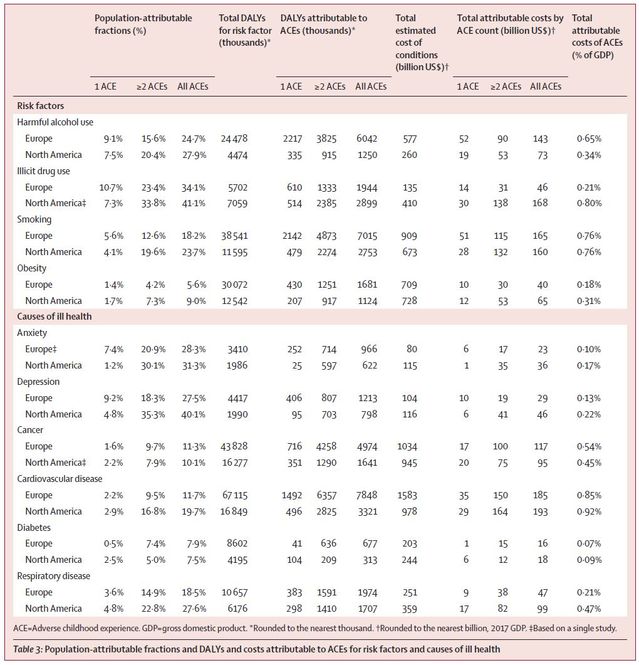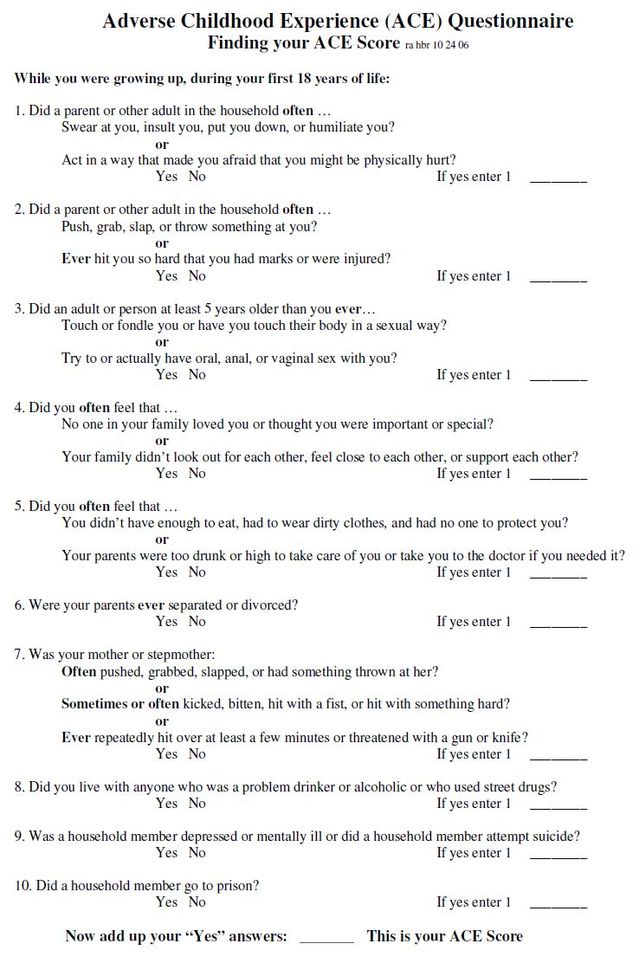Adverse Childhood Experiences
How Adverse Childhood Experiences Cost $1.33 Trillion a Year
Research takes a deep dive into large-scale impact of harm to children.
Posted September 14, 2019 Reviewed by Kaja Perina
You use your platforms and voices to both raise awareness and enforce change and be change, and I feel deeply that there is nothing more respectable one with such a platform can do. — Lady Gaga
The original groundbreaking Adverse Childhood Experiences (ACE) Study, Relationship of Childhood Abuse and Household Dysfunction to Many of the Leading Causes of Death in Adults (1998) led to an expanding awareness of the suffering, cost and burden illness wreaked by childhood abuse and neglect.
Looking at data from from over 17,000 patients in a California HMO, they found that patients with greater than 4 ACEs were at increased risk for a variety of serious problems: “4- to 12-fold increased health risks for alcoholism, drug abuse, depression, and suicide attempt; a 2- to 4-fold increase in smoking, poor self-rated health, ≥50 sexual intercourse partners, and sexually transmitted disease; and a 1.4- to 1.6-fold increase in physical inactivity and severe obesity.”
Subsequent research has looked at various other aspects of the negative effects of ACEs, on educational achievement, physical and mental health outcomes and biological markers of disease, and impact on individuals, families, communities and society.
A Global Scourge
ACEs represents a chronic epidemic which hurts the entire planet. Not only that, ACEs are perpetrated by our species against itself, as adults both permit and directly enact abuse and neglect on children. Those children of course grow up to be shaped by their developmental experiences, and so the cycle repeats.
While it is deeply inspiring and a testament to the human spirit that many resilient people thrive following adversity (Chris Bergland discusses PCEs positive childhood experiences mitigating effects here), and go on to do great things, the overwhelming effect is negative. Post-traumatic growth does not justify trauma and neglect.
The state of the planet and our culture has itself become an adverse childhood experience. The environment we have created is psychologically and physically toxic to us. And we keep it going as-is.
We can study specific outcomes, economic costs, health impact, biological pathways, effects on the healthcare system, and so on. At this time, it is possible only to speculate about the overall impact on our society.
Consider the evolutionary impact of generations of ongoing trauma to children. It shapes the very essence of our species, defining who we are. It shapes culture and mind, and must impact how we make collective decisions, how we respond to threats such as the climate crisis and gun violence, what we expect from one another — and how we must position ourselves defensively to protect ourselves from one another.
I want you to feel the fear I feel every day. And then I want you to act. I want you to act as you would in a crisis. I want you to act as if our house is on fire. — Greta Thunberg
In a world where an estimated 1 billion children around the globe experience violence (Hillis, Mercy, Amobi and Kress, 2016) — let alone famine, disease, a lack of sanitation, substandard education, and so on — How do we live with this?
The Big Picture
Because much of the research on ACEs has been a variety of smaller and larger studies looking at different outcomes across many different populations, a large-scale consolidation of the existing data is in order. To accomplish this, as reported recently in The Lancet, Public Health, researchers Bellis, Hughes, Ford, Rodrigues, Sethi, and Passmore (2019) from the World Health Organization (WHO) conducted a systematic review and meta-analysis of studies from Europe and the USA looking at ACEs outcome data.
In order to conduct research like this, scientists first identify every possible study done on a given theme. Through a process of painstaking elimination they cone down on only the high quality, non-overlapping studies. They then apply statistical techniques to pool the data to identify common measures, or align data when different measures have been used, in order to calculate the “relative risk” of various outcomes as a function of how many ACEs a given person has experienced.
For this study, they found 4387 articles, and included studies measuring ACEs with at least 1000 people. Eliminating studies which they could use, for example with too few participants, data from earlier studies, poor research methods, they ended up with 23 high-quality articles to analyze, including 11 studies in Europe and 12 in North America, mainly the United States.
The studies ranged in size from 1,500 to 978,647 people, and two looked were population studies following individual from birth. The ACEs reviewed included child emotional, physical and sexual abuse, exposure to violence in the home, break up of the family, and drug abuse, mental illness or crime within the household. The full ACEs scale is at the end of this piece, and may be triggering.
Dire Findings
Among the 1,514,254 people in the European sample, 23.5 percent had one ACE, and 18.7 percent had two or more. Among the 121,341 in North America, 23.4 percent had one ACE, and 35 percent had two or more. North America, primarily the USA, had nearly double more severe ACEs than the European group.
For both groups, illicit drug abuse was most strongly associated with ACEs, among the factors studied. Illicit drug abuse was 34.1 percent more common in Europe and 41.1 percent in North America, with annual financial losses of $46 billion and $168 billion, respectively as a result of direct and indirect costs.
About 25 percent of harmful alcohol use in both regions was from ACEs, adding up to $143 billion and $73 billion, respectively, in Europe and North America. ACEs was associated with 18.2 percent and 23.7 percent, respectively of the incidence of cigarette smoking, costs of $165 billion and $160 billion. Rates of obesity due to ACEs was comparatively low, but costs added up to $40 billion and $65 billion.
For health outcomes, ACEs were most highly connected with mental illness, accounting for an estimated 30 percent of anxiety disorder and 40 percent of depression, with a total price tag of $51 billion and $82 billion in Europe and North America. After mental health, lung disease was the next most impacted by ACEs, from 20-25 percent across both continents, ringing up costs of $146 billion across both regions. While cardiovascular disease and cancer were relatively less associated with ACEs, the costs were very high due to the nature of these illnesses.

A Vicious Cycle
The majority of the costs were from two or more ACEs, as compared with only one ACE. The negative synergy of having more than one ACEs is massive.
For example, for more ACEs with alcohol abuse, 63 percent of the cost came from those with two or more ACEs. For anxiety, 96 percent of the cost came from those with two or more ACEs.
The total annual costs from ACEs tallied were $581 billion in Europe (2.67 percent GDP) and $748 billion in North America (3.6 percent GDP). In Europe, these 77 percent of the cost came from two or more ACEs, and 82 percent in North America. That's $1.329 trillion per year, in North American and Europe alone. Most of that is from two or more ACEs.
The study authors calculated than even a 10 percent reduction in the rates of two or more ACEs would translate to an annual saving totaling $105 billion across both regions, equivalent to a total reduction 3 million DALYs (Disability-Adjusted-Life-Years, a measure of global burden of disease from sickness and death). These are profound findings.
What Can We Do?
It’s a sad fact of our world that so many children (and adults) are exposed to violence, trauma, abuse and neglect. The cost in terms of dollars is startling, and the fact that much of this suffering is from commercial sales of harmful substances is a collective shame. Adverse childhood experiences, in principle, should be easy to prevent. Doing so would prevent illness and suffering, and free up financial resources for better use than damage-control for species-specific self-inflicted wounds.
However, it is not so simple. The impact of intergenerational transmission of trauma, the impact of the social determinants of illness, the lack of systems to divert resources to areas in need, the collective moral challenge we are facing, our addiction to war and aggression, and other factors means it is not appropriate to blame individuals for the high rate of ACEs we see. Human beings seem to be the only animals who do this kind of thing on such a grand scale. We don't truly know why, but this is a question of ever-more-pressing urgency.
Complacency Is Lethal
If there is a call to action, it is to first raise awareness. With collaboration, compassion and reason, and especially by empowering and educating the younger generations stuck with this terrible bill, can we hope for a different kind of world, and a different kind of human being.
Future research will further define the scope of the problem we are facing. Importantly, identifying high-value areas for intervention and testing the impact of interventions is needed to direct limited resources to the highest value targets.
Diverting resources from destructive behaviors to constructive behaviors is a heavy lift for the capitalist mindset, indeed for any mindset perhaps. But even the most "greedy" capitalist mindset could be swayed by a deep understanding of the data. We see this, for instance, as some insurance companies are finally persuaded to pay for mental health treatment... but only as they come to see that doing so saves them billions in the future. Long-term thinking is sorely lacking.
Preventing ACEs is of urgent importance, as is mitigating the negative impact of ACEs currently, in terms of substance and alcohol abuse, mental illness, physical health outcomes, and the cost to society. Understanding whether ACEs are also associated with the problems facing society, including climate issues, mass violence, and in general impaired collective decision-making, would be helpful for raising awareness, changing attitudes and catalyzing change.
ACEs Questionnaire - Trigger Warning

ExperiMentations Blog Post ("Our Blog Post") is not intended to be a substitute for professional advice. We will not be liable for any loss or damage caused by your reliance on information obtained through Our Blog Post. Please seek the advice of professionals, as appropriate, regarding the evaluation of any specific information, opinion, advice, or other content. We are not responsible and will not be held liable for third party comments on Our Blog Post. Any user comment on Our Blog Post that in our sole discretion restricts or inhibits any other user from using or enjoying Our Blog Post is prohibited and may be reported to Sussex Publishers/Psychology Today. Grant H. Brenner. All rights reserved.
Facebook image: ZouZou/Shutterstock
LinkedIn image: Eakachai Leesin/Shutterstock




